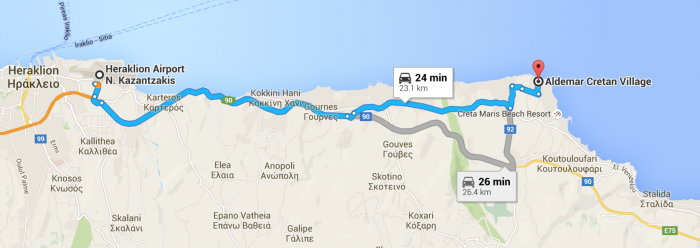
| To Heraklion Int. airport | 23km |
| To Heraklion harbour | 25km |
| To Heraklion town |
25km |
| To Hersonissos village | 2km |
| To Agios Nikolaos town | 30km |
CRETE: The Birthplace of Hospitality!
General
Crete is the largest of all the Greek islands. With a total surface of 8,336 sq m it has 1,100 km of coastline and approximately 600,000 inhabitants. Crete is also considered to be one of the most prosperous areas in Greece. Development on the island has been favoured by its geographical location, climate and diverse natural beauty, as well as, its unique cultural and historical heritage. Crete is renowned for its breath-taking mountain ranges and long sandy beaches that take you right down to its deep-blue seas. The climate and geography of Crete provide for many different species of wild-life. Over 100 different sorts of flowers and plants can be found: in the high mountains and the thirteen deep gorges on the island (the best known of which is Samaria gorge). Visitors may encounter interesting flora and fauna in its valleys and semi-maountainous areas, including the rare species of wild goat called the kri - kri, unique to this area. Crete is noted for its geographical diversity, which ranges from numerous small surrounding islands to splendid plateaus like Lassithi, with its eye-catching windmills.
History
The history of Crete dates from the pre-historic era. Millions of years ago, Aegis, the land that joined Greece to Asia Minor, sank into the Mediterranean Sea and only the peaks of its mountains remained above the surface of the waters to form Crete and its surrounding islands.
Its location, has meant that Crete has been a crossroads for several civilizations. From 2000 BC onwards, the unique Minoan Civilization built 100 cities and the island also boasts remains dating back to the Ancient Greek and Roman periods, the early Christian era, the Byzantine Empire, the Venetian rule, and the Ottoman occupation, as well as, the trappings of modern Greek civilization. Venetian fortresses can be found in its harbours and beautifully preserved old towns and a multitude of monasteries and Byzantine churches are scattered throughout the island. The plethora of sights on offer attracts many visitors today.
Contemporary Crete and Iraklio (Heraklion) - Travel Tips!
The island of Crete is the largest of the Greek islands, with a total area of 8,336 km2, 1,100 km of coastline and a population of around 600,000. Crete has around nine thousand years of fascinating history, rich in events and periods of turbulence – with its Minoan civilization, Byzantine rule, Saracen pirates, Venetian rule, Ottoman domination and revolutions, culminating in its unification with the rest of Greece less than a century ago.
Crete is well known for its natural beauty and impressive mountain ranges, ravines, long stretches of beach leading into deep blue seas, numerous smaller islands, plateaus and fertile plains. The island also hosts over 100 different species of flowers and herbs which are unique to Crete. Its special cuisine stems back to the Minoan period, font for the modern trend for the Mediterranean diet.
In all aspects of life, its people bring another dimension to conviviality, mourning, festivities and daily routine. Crete is home to many poets, as well as endless satirical and laudatory four line couplets, set to the mandolin or lyre, and wonderful a capella music of its streets and hostelries. The journey round Crete has many different facets and traditions which continue through time and provide a source of fascination for the visitor.